Pictures of Wartburg College 1894-1935
All images are clickable and lead to a larger image.
Faculty of Wartburg
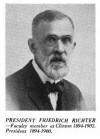

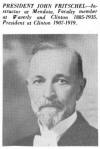

Presidents Friedrich Richter, Otto Kraushaar, John
Fritschel and Otto Proehl
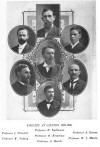
Faculty at Clinton, 1902-1906: Professor H. Kuhlmann,
Professor J. Fritschel, Professor W. Nolting, Professor O.
Kraushaar, Professor A. Bartels, Professor A. Estrem, Professor W.
J. Martin
Wartburg College Buildings
This was the main building on the Clinton campus of Wartburg College. The 97 acres of land that the college was built on was purchased from Chancey Lamb for $25,000.00 and construction began in 1893. This main building cost $45,913.50 to build and was opened in 1894.
Enrollment peaked at approximately, 250 students in 1926 after the college became co-educational. In 1934, it was announced that the college would be moved to Waverly, Iowa. Despite monetary pledges of $60,000.00, from the citizens of Clinton for a new science building, the college was moved after the 1935 graduating class.
This building was converted into apartments during World War II but fell into disrepair and was demolished in May of 1998. |
 |
| Cotta Hall was the last building built on the Clinton campus and was primarily a male dormitory with the physics and chemistry labortory housed in the semi-basement. This building was also coverted into apartments during World War II. |
 |
| The College President's Home was built in 1928. |
 |
| The College Chapel with its magnificent pipe organ. The organ was dismantled and removed to the Waverly campus in 1935. |
 |
| The Wartburg College Museum contained 5,000 specimen, largely from New Guinea. |
 |
| The Wartburg Gymnasium was built in 1907 with contributions from the citizens of Clinton as well as Emma Lamb Young. It was built at Glendale and College Avenue and later was converted into a residence by Emil Morris a Clinton clothier. |

 |
Three pages from the quarterly Wartburg College Bulletin issued June 1933, showing various campus locations on the Clinton campus.

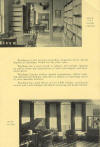
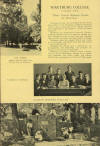
|
| |
Demolition of the Main Building in May of 1998.
Shown here is the recovery of the cornerstone which is now part of a display at the Clinton County Historical Society Museum in Clinton.

















